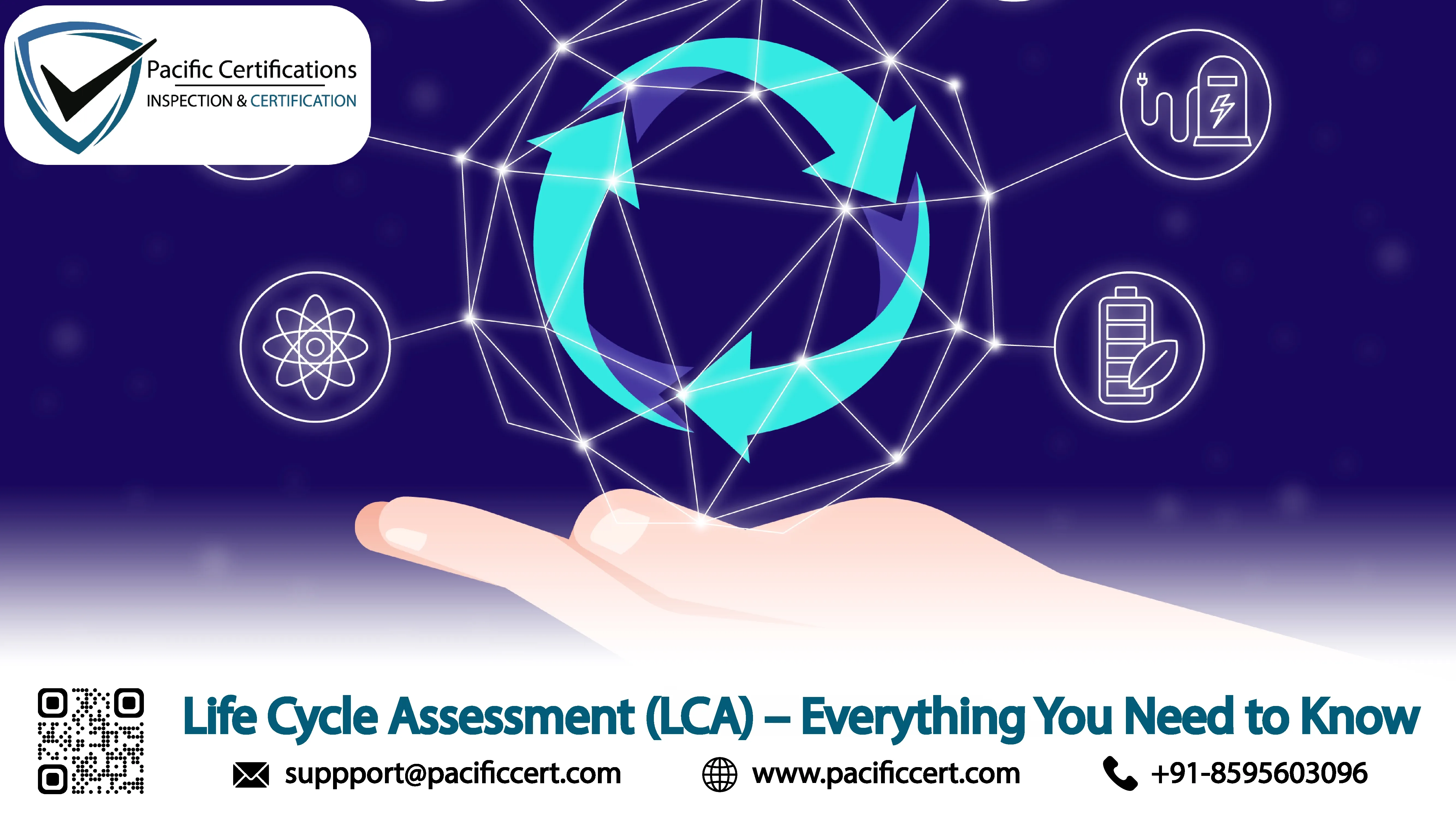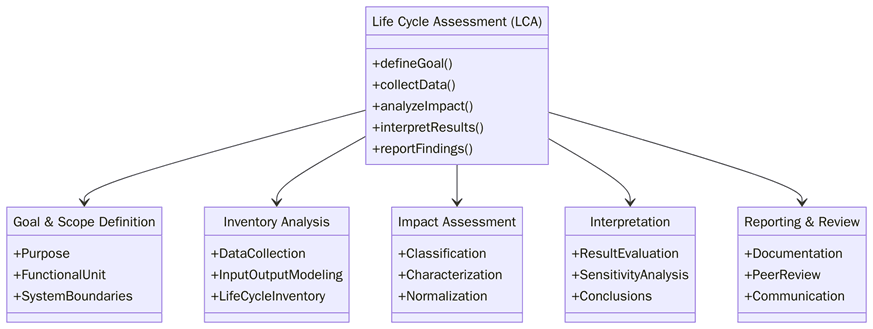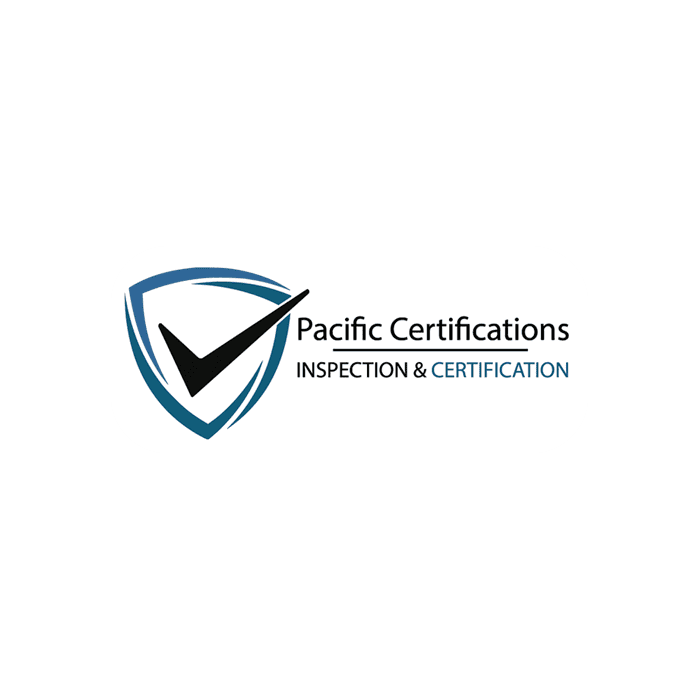Life Cycle Assessment (LCA) – Everything You Need to Know

Introduction
As global sustainability efforts intensify, businesses are under increasing pressure to measure and manage their environmental impact more transparently. Life Cycle Assessment (LCA) has emerged as one of the most comprehensive tools for evaluating a product or service’s total environmental footprint—from raw material extraction to end-of-life disposal.
An LCA doesn’t just identify where emissions or waste occur; it helps organizations make smarter design, sourcing and production decisions that align with both sustainability goals and market expectations. Whether you’re a manufacturer, service provider, or policymaker, understanding LCA is essential to building accountability and credibility in environmental performance.
Talk to an auditor at Pacific Certifications to understand how integrating LCA into your ISO 14001 or sustainability strategy can improve performance and reporting accuracy.
Quick summary
A Life Cycle Assessment (LCA) is a systematic process that quantifies environmental impacts associated with all stages of a product’s life. This includes resource extraction, manufacturing, transportation, usage and disposal. By using internationally recognized methodologies (ISO 14040 and ISO 14044), LCA enables organizations to make data-driven decisions that minimize waste, reduce emissions and improve energy efficiency.
It helps businesses evaluate trade-offs between materials, technologies and processes—empowering them to design more sustainable products while reducing long-term operational costs.
Why Life Cycle Assessment matters for organizations?
Organizations today are being evaluated not only on what they produce but also on how they produce it. Governments, consumers and investors increasingly expect transparency around carbon emissions, water use and material sourcing. LCA provides a scientifically grounded way to measure these impacts and integrate sustainability into decision-making.
By incorporating LCA, companies can identify high-impact processes (“hotspots”), justify sustainability investments and improve their ESG disclosures. It also plays a critical role in achieving ISO 14001 certification and aligning with climate reporting frameworks such as GHG Protocol, CDP and ISO 14067 (Carbon Footprint of Products).
“A well-conducted Life Cycle Assessment transforms environmental management from guesswork into precision—helping organizations identify hidden impacts, optimize resource use and strengthen credibility with regulators and customers alike.”
Key stages of a Life Cycle Assessment
An LCA typically follows four stages as outlined in ISO 14040 and ISO 14044. Each stage builds upon the previous one to provide a complete environmental profile of the product or system.
1. Goal and scope definition
Organizations first define the purpose, system boundaries and key assumptions of the study. This includes specifying what will be analysed (product, service, or process) and identifying functional units such as “per kilogram of product” or “per year of operation.”
2. Inventory analysis (LCI)
In this stage, all material and energy inputs, emissions and waste outputs are collected. This data forms the foundation of the assessment. It typically includes raw material extraction, manufacturing, transportation, use and end-of-life data.
3. Impact assessment (LCIA)
The data collected in the LCI is translated into measurable environmental impacts—such as global warming potential, water depletion, eutrophication, acidification, or human toxicity. This step helps decision-makers understand the environmental significance of each stage.
4. Interpretation
Finally, results are analysed to identify major impact sources, validate data reliability and develop strategies for improvement. The findings are then used to guide eco-design, supplier selection and carbon reduction initiatives.
What are the requirements for conducting an LCA?
To perform an accurate and credible LCA, organizations must establish a clear methodology and maintain consistent data integrity throughout the process. Below are the key requirements:

- Define the goal, scope and functional unit of the study.
- Identify system boundaries, including upstream (raw materials), core (production) and downstream (distribution, use, disposal) phases.
- Collect detailed inventory data on materials, energy consumption and emissions.
- Use recognized LCA databases such as Ecoinvent or GaBi for reference data.
- Choose relevant impact categories (e.g., GHG emissions, water use, toxicity).
- Apply calculation models as per ISO 14040/14044 methodology.
- Review results for consistency, transparency and data quality.
- Communicate results in line with ISO 14044 reporting requirements.
- Validate through internal or third-party review for credibility.
- Integrate LCA findings into sustainability strategies and product design.
Tip: Begin with a simplified “screening LCA” to identify major environmental hotspots before investing in a full-scale analysis.
How to prepare for Life Cycle Assessment?
Implementing an LCA involves careful planning and collaboration between departments. Below are the key points:
- Secure leadership approval and define objectives.
- Identify the product or process for assessment and determine data needs.
- Gather input from supply chain partners, R&D teams and production units.
- Select LCA tools or software compatible with ISO 14044 requirements.
- Train internal teams on data collection and interpretation techniques.
- Validate the accuracy of data and models through pilot assessments.
- Develop action plans to reduce impacts based on findings.
Certification audit
While ISO 14040 and ISO 14044 do not provide certification themselves, organizations can have their LCA process audited under ISO 14001 or as part of sustainability assurance.
Stage 1 audit: Reviews the defined scope, boundaries and methodology.
Stage 2 audit: Verifies data collection, calculation models and accuracy of results.
Nonconformities: Must be corrected before LCA data can be used in environmental declarations.
Management review: Confirms that LCA outcomes are used to improve performance.
Surveillance: Annual reviews ensure consistency and alignment with current data and processes.
What are the benefits of conducting a Life Cycle Assessment?
Performing a Life Cycle Assessment delivers a range of financial, operational and environmental advantages. Below are the key benefits:

- Clear visibility of environmental impact across all life stages of a product.
- Data-driven insights to reduce energy, water and material consumption.
- Identification of cost-saving opportunities through waste minimization.
- Improved product design for recyclability and longer life cycles.
- Enhanced brand reputation and customer confidence.
- Stronger compliance with ISO 14001 and sustainability disclosure frameworks.
- Better supply chain transparency through validated data sharing.
- Quantified KPIs such as CO₂ reduction, resource efficiency rate and waste diversion.
- Support for eco-labelling, product declarations and carbon footprint reporting.
- Long-term resilience through improved resource planning and environmental accountability.
Market Trends
In recent years, LCA has become a mainstream tool for sustainability reporting. Companies across the automotive, construction, packaging and consumer goods sectors are using LCA to achieve circular economy goals and reduce Scope 3 emissions. Digitalization has accelerated the adoption of AI-assisted LCA tools that automate data collection and scenario modelling, making it easier for even small and medium enterprises to adopt lifecycle-based decision-making.
By 2030, Life Cycle Assessment will play a central role in global carbon accounting and green product certification. Integration with real-time IoT data and blockchain-based traceability will make LCA results verifiable and auditable across supply chains. Governments are expected to include LCA-based reporting in public procurement and carbon labelling requirements, making early adoption a key competitive advantage for forward-thinking businesses.
Training and courses
Pacific Certifications provides accredited training programs to help organizations and professionals understand and implement Life Cycle Assessment (LCA) under ISO 14040 and ISO 14044 guidelines:
- Lead Auditor Training: Designed for sustainability and compliance professionals responsible for evaluating environmental data systems. The course covers LCA principles, data verification and audit methodologies.
- Lead Implementer Training: Ideal for environmental engineers, sustainability managers and product designers looking to apply LCA in design and operational processes. It covers boundary setting, data modelling, impact evaluation and report development.
Contact [email protected] to schedule your LCA training or awareness session and integrate lifecycle thinking into your environmental management strategy.
How Pacific Certifications can help?
Pacific Certifications supports organizations in verifying and validating their Life Cycle Assessment (LCA) processes through impartial third-party audits. While ISO 14040 and ISO 14044 are not certifiable standards, organizations can obtain a Certificate of Compliance after successful assessment of their LCA methodology, data integrity and reporting alignment with these standards.
Our auditors evaluate how your LCA system aligns with the principles and framework of ISO 14040 and 14044, ensuring transparency, traceability, and methodological accuracy. For organizations already certified to ISO 14001, an LCA compliance audit provides additional assurance that environmental decisions are based on quantifiable, verifiable data.
Pacific Certifications focuses solely on auditing and certification of management systems, not consulting, ensuring independence and credibility in every compliance review.
To request an LCA compliance audit or integrate it with your ISO 14001 Environmental Management System, contact us at [email protected] or visit www.pacificcert.com.
Ready to get ISO certified?
Contact Pacific Certifications to begin your certification journey today!
Author: Alina Ansari
Suggested Certifications –
Read more: Pacific Blogs

